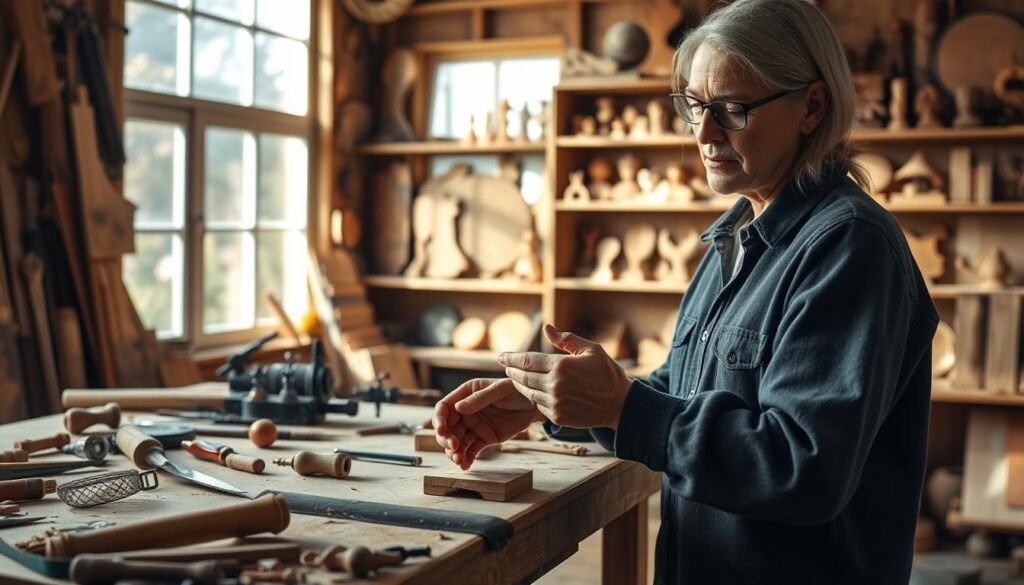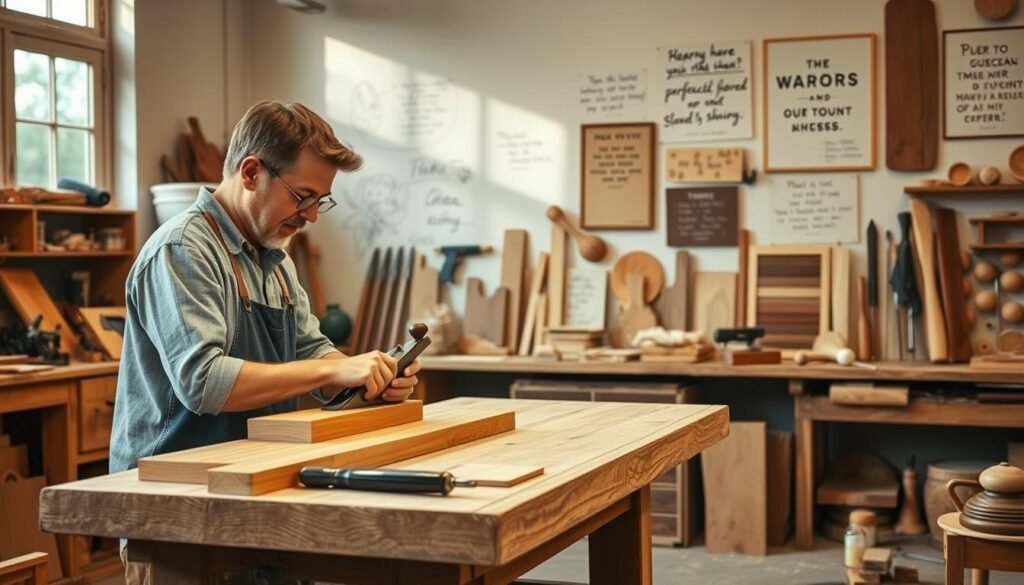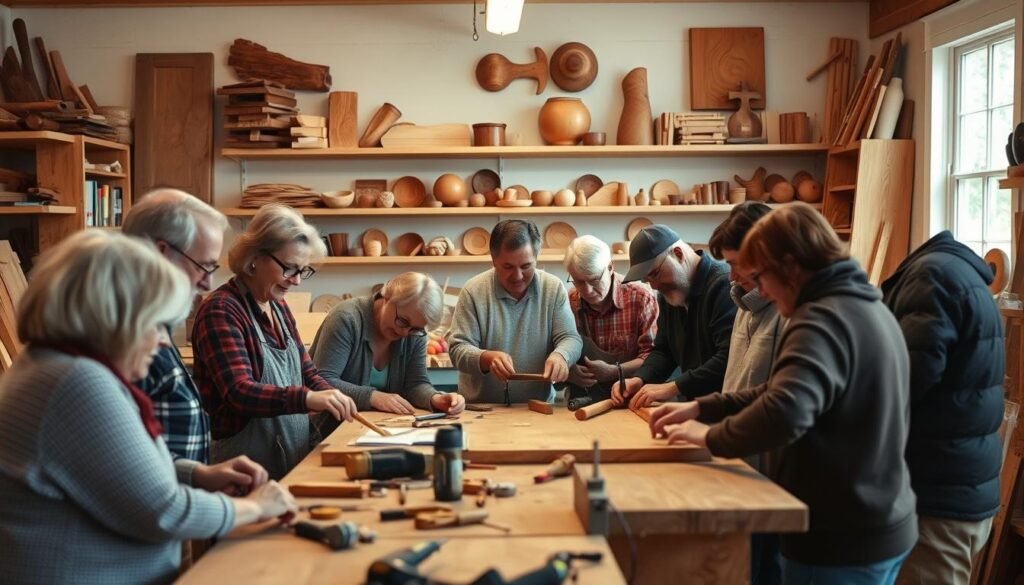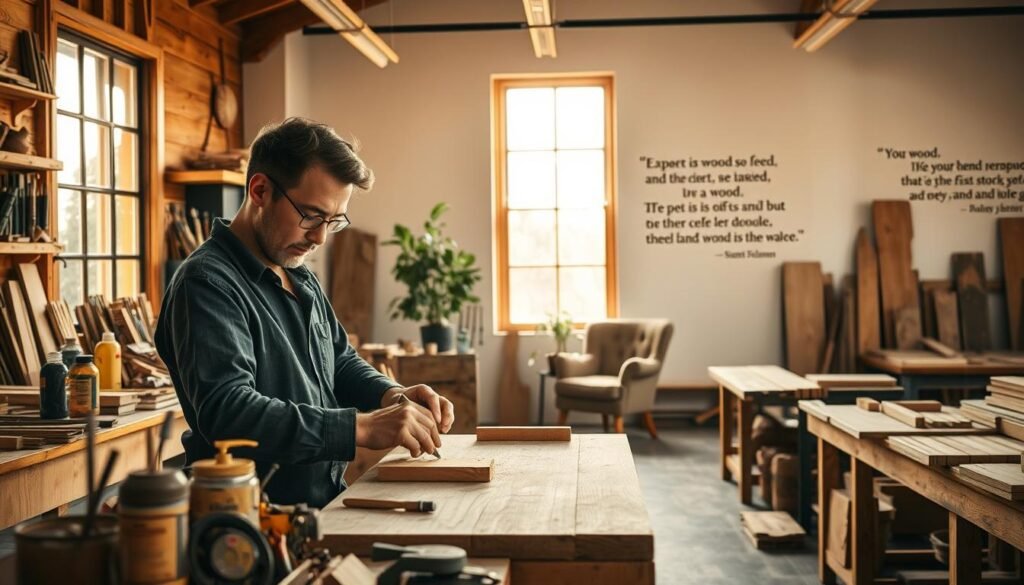Have you ever felt calm while creating something with your hands? For many, woodworking is a therapeutic escape. It lets us channel our emotions into something real and meaningful. Let’s dive into woodworking therapy and see how it can help our mental health.
Woodworking for mental health mixes creativity with physical activity. It’s a special way to reduce stress and improve emotional well-being. As you work with wood, you might find it meditative. It helps you stay in the moment and forget your worries. The benefits of woodworking therapy are many, and we can’t wait to share them with you.
Key Takeaways
- Discover how woodworking can be a therapeutic activity for mental health
- Learn about the benefits of combining creativity with physical activity
- Explore the meditative aspects of working with wood
- Understand how woodworking therapy can be a unique approach to stress relief
- Find out how to get started with woodworking for emotional well-being
You may also like
The Therapeutic Power of Working with Wood
Woodworking has a big impact on our mental and emotional health. It’s more than a hobby; it’s a journey that mixes creativity with mindfulness.
How Woodworking Affects the Brain
Woodworking changes how our brain works and improves our mental health. It involves tasks that need focus, problem-solving, and hand skills. These tasks can make our brain’s reward system work better.
Neurological Benefits of Hands-on Creation
Creating something with our hands releases dopamine, which makes us feel good. This can help reduce anxiety and depression.
The Psychology of Making Something Tangible
Creating something real through woodworking makes us feel proud and accomplished. This boosts our self-esteem and confidence, helping our mental health.
Research Supporting Craft-Based Therapy
Research shows that crafts like woodworking can lower stress and anxiety. Working with wood can be calming and meditative. It helps distract us from daily stress.
| Therapeutic Benefits | Description |
|---|---|
| Stress Reduction | Woodworking can lower cortisol levels, reducing stress. |
| Anxiety Management | Working with wood can calm anxiety symptoms. |
| Improved Focus | Woodworking requires concentration, improving focus and mental clarity. |
“The creative act is not only an expression of oneself, but also a means of perceiving the world and our place within it.”
Understanding woodworking’s therapeutic power can help us improve our mental health. Whether you’re experienced or new, woodworking therapy is rewarding and healing.
Understanding Woodworking Therapy
Woodworking therapy is a form of therapy that uses woodworking to help people. It helps people become more mindful and feel better emotionally. This therapy is based on the idea that making things with wood can be healing.

👉 👉Start your woodworking journey with Ted’s 16,000 plans »
Definition and Core Principles
Woodworking therapy mixes the joy of woodworking with therapy to help mental health. It focuses on the journey of making something, not just the end result. It encourages mindfulness and lets people express themselves.
Historical Context of Wood as a Healing Medium
Wood has been seen as healing in many cultures for a long time. Some believed wood had special healing powers. Even though these ideas might not be proven today, working with wood can be very calming.
“The tactile experience of woodworking can be very grounding,” says a woodworking therapist. “It’s a way to connect with the natural world and find calm.”
Modern Applications in Mental Health Treatment
Now, woodworking therapy is used in many places to help with mental health. It helps people with anxiety, depression, and more. By using woodworking for mindfulness, therapists help people find peace and feel better.
As one therapist notes, “Woodworking therapy offers a unique mix of creativity and mindfulness. It can be very therapeutic.”
Mental Health Benefits of Woodworking
Working with wood can bring many mental health perks. It can lower stress and boost focus. This mix of physical activity and creativity makes it great for mental health.

👉 👉Start your woodworking journey with Ted’s 16,000 plans »
Stress Reduction and Anxiety Management
Woodworking is a strong tool for managing stress and anxiety. The physical work with wood is calming. The creative process also takes our minds off daily worries.
How Repetitive Actions Calm the Nervous System
Woodworking’s repetitive tasks, like sanding, calm the nervous system. This can lessen anxiety and help us relax.
Creating Distance from Ruminating Thoughts
Woodworking helps us focus on the task, pushing aside worries. This is very helpful for those with anxiety or depression.
Improved Focus and Mindfulness
Woodworking demands focus and detail, boosting mindfulness and concentration. We must be fully present while working on a project.
Building Self-Esteem Through Creation
Creating something with our hands boosts self-esteem and confidence. Completing projects gives us pride and accomplishment. This pride can improve other areas of life.
Adding woodworking to our lives can bring these mental health benefits. It can enhance our well-being and quality of life.
Setting Up Your Therapeutic Woodworking Space
To enjoy woodworking’s calming effects, create a peaceful workspace. A tidy and calm area boosts the benefits of woodworking therapy. It’s perfect for easing anxiety and improving your mood.
Essential Tools for Beginners
Beginners need basic tools that are easy to use. Knowing these tools helps you start projects without feeling stressed.
Basic Hand Tools for Starting Out
Start with tools like a tape measure, square, chisel set, hand saw, and clamps. These are key for most projects and help build your skills.
Power Tools: When to Introduce Them
When you feel more confident, add power tools to your space. Begin with a table saw or cordless drill. Always follow safety rules to prevent injuries.
Creating a Calming Workshop Environment
A calm environment is key for woodworking for anxiety. Think about your space’s lighting, noise, and feel. Soft lights, comfy temps, and few distractions make a peaceful place for woodworking.

👉 👉Start your woodworking journey with Ted’s 16,000 plans »
Safety Considerations for Therapeutic Practice
Always put safety first in your woodworking area. Make sure there’s good air, wear protective gear, and keep things tidy to avoid accidents.
| Safety Measure | Description | Importance Level |
|---|---|---|
| Proper Ventilation | Ensures good air quality and reduces dust inhalation | High |
| Protective Gear | Safety glasses, earplugs, and dust masks protect against injuries and health risks | High |
| Organized Workspace | Reduces clutter and minimizes the risk of accidents | Medium |
Creating a safe and calming woodworking space boosts the benefits of woodworking therapy. It makes your woodworking journey rewarding and enjoyable.
How to Begin Your Woodworking Therapy Journey
Woodworking therapy is a unique way to heal. Starting is simple. You’ll find working with wood is therapeutic and fulfilling, helping your mental health.
Assessing Your Needs and Setting Intentions
Before starting, think about what you need and what you want to achieve. Ask yourself what you hope to get from woodworking therapy. Do you want to reduce stress, improve focus, or boost self-esteem?
Knowing your goals helps you choose projects that meet your emotional needs.
Selecting Projects That Match Your Emotional Goals
Choosing the right project is key in woodworking therapy. Pick projects that match your emotional goals and skill level. For beginners, a simple birdhouse is a good start.
If you’re up for a challenge, go for more complex projects. They require patience and dedication.

👉 👉Start your woodworking journey with Ted’s 16,000 plans »
Step-by-Step Approach to Your First Healing Project
Once you’ve picked your project, it’s time to start. Prepare your materials and get your mind ready. Make sure you have all the tools and materials you need. Take a few deep breaths to calm your mind and focus.
Preparing Your Materials and Mindset
Preparation is essential for a successful woodworking therapy experience. Gather all your materials. Take a few deep breaths to calm your mind. This helps you stay focused and present.
Working Through Emotional Blocks
As you work, you might face emotional blocks or challenges. Don’t worry, these are chances for growth and healing. Take your time. Remember, the journey is as important as the end result.
By following these steps and being patient with yourself, you can start a rewarding woodworking therapy journey. It will nurture your mental health and well-being.
Mindful Woodworking Techniques
Woodworking is a special way to practice mindfulness. It lets us be fully in the moment. As we work with wood, we notice our thoughts, feelings, and body sensations more. This makes the experience more therapeutic.

👉 👉Start your woodworking journey with Ted’s 16,000 plans »
Incorporating Breathing Exercises While Working
Adding breathing exercises to woodworking can boost mindfulness. Take slow, deep breaths while you work. Focus on how the breath moves in and out of your body. This calms your mind and lowers stress.
The Meditative Process of Sanding and Finishing
Sanding and finishing are key steps in woodworking that can be meditative. The motion of sanding is soothing. It helps you focus on the task and ignore distractions. Working towards a smooth finish teaches patience and attention to detail.
Finding Flow State Through Repetitive Tasks
Repetitive tasks, like cutting or assembling, can put you in a flow state. You’re fully engaged and lose track of time. This state brings focus, enjoyment, and fulfillment.
| Mindful Technique | Benefits | Application in Woodworking |
|---|---|---|
| Breathing Exercises | Reduces stress, calms the mind | Take deep breaths while working |
| Sanding and Finishing | Cultivates patience, attention to detail | Focus on achieving a smooth finish |
| Repetitive Tasks | Promotes flow state, enjoyment | Engage in tasks like cutting or assembling |
Using these mindful woodworking techniques can make woodworking more therapeutic. It helps you feel better and more fulfilled.
Therapeutic Woodworking Projects for Different Needs
Woodworking can help with emotional healing. It’s important to choose projects that meet specific emotional needs. This way, woodworking therapy can help with various mental health challenges.
Projects for Managing Depression and Anxiety
Woodworking can help those with depression and anxiety. Projects that involve repetitive motions or creative expression are best. They can calm the mind and lift the mood.
Simple Boxes: Containing Difficult Emotions
Making simple boxes can help manage tough emotions. The act of measuring, cutting, and assembling is calming. The finished box shows one’s ability to handle emotions.
Wall Art: Expressing Inner Feelings
Wall art lets people show their feelings through design and color. It’s empowering for those with depression. It helps them process and express their emotions.
Woodworking for PTSD and Trauma Recovery
Woodworking is great for PTSD and trauma recovery. It’s a safe way to express emotions. Projects like upcycling old wood are very meaningful.
These projects transform old wood into something valuable. It’s like healing and recovery in action.
Addressing Addiction Through Creative Work
Woodworking can help with addiction. It offers a healthy way to express creativity and relieve stress. It gives a sense of purpose and fulfillment.
By focusing on the creative process, people can resist addictive behaviors. It builds resilience against addiction.

👉 👉Start your woodworking journey with Ted’s 16,000 plans »
Building Community Through Woodworking
Woodworking is more than just a hobby; it’s a way to connect with others. Sharing your passion with like-minded people can make the experience even more rewarding. It boosts the mental health benefits you get from woodworking.
Finding or Starting a Therapeutic Woodworking Group
Looking for a woodworking group? Check out local clubs, community centers, or mental health groups. You can also find people online who love woodworking. Starting a group is easy. Just invite friends to join you in a project. This way, everyone can support each other and learn together.
Sharing Your Journey and Creations

Showing off your woodworking can be very fulfilling. Use social media, blogs, or local shows to share your work. It helps you meet others who enjoy woodworking. Plus, it might inspire them to try it too.
👉 👉Start your woodworking journey with Ted’s 16,000 plans »
Conclusion: Embracing the Healing Journey of Woodworking
Woodworking is more than just a hobby. It’s a healing tool that can change lives. It helps with mental wellness and emotional balance. Adding woodworking to your self-care can reduce stress and anxiety.
Woodworking can help with anxiety by focusing on the now. It offers a calm escape from daily stress. Remember, the journey of woodworking is as valuable as the finished product.
Woodworking helps you connect with yourself and the world. So, start your woodworking journey. Let it lead you to a more balanced and creative life.
🛠️ Want the Look Without the Sawdust? Here’s Your Shortcut
There’s something rewarding about building a wooden piece with your own hands—but let’s face it, not everyone has the time, tools, or space for a full DIY project.
💡 That’s why I recommend Ted’s Woodworking Plans – a massive library of 16,000+ step-by-step plans for every kind of woodworking project you can imagine. From pet houses to holiday gifts, you’ll get:
✨ Easy-to-follow blueprints
🧰 Complete material & cut lists
🪚 Projects for all skill levels
👉 👉Start your woodworking journey with Ted’s 16,000 plans »
FAQ
🔍What is woodworking therapy, and how can it benefit my mental health?
🔍I’m a beginner; can I start woodworking therapy?
🔍How do I create a calming workshop environment for woodworking therapy?
🔍What kind of projects are suitable for managing depression and anxiety?
🔍Can woodworking therapy be done in a group setting, or is it more effective solo?
🔍How can I incorporate mindfulness into my woodworking practice?
🔍Are there any safety considerations I should be aware of when practicing woodworking therapy?
🔍Can woodworking therapy be used in conjunction with other forms of therapy or treatment?
Affiliate Disclosure
Some of the links in this article are affiliate links. If you click through and make a purchase, I may earn a small commission — at no additional cost to you.
This helps support my work so I can continue creating helpful woodworking tutorials and product reviews.I only recommend products and services that I have thoroughly researched and believe could provide real value to my readers.
Thank you for your support!

